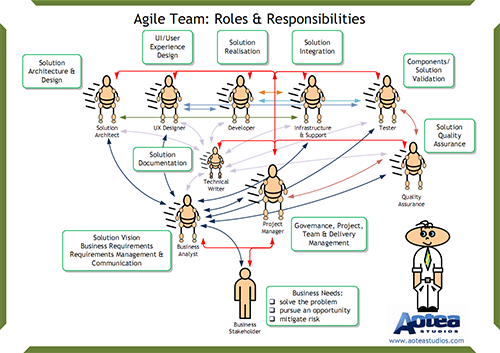Agile team: roles and responsibilities
This post shows a chart of roles and responsibilities within an Agile team. It also discusses the role of the business analyst (spoiler: it’s still vital).
We got a request from one of our readers to create a poster about the roles and responsibilities in an Agile team. Here is our view on the subject:
The team consists of a set of roles. Each role is responsible for the designated knowledge area (being a key resource for the area). Other roles can share or substitute this role where required. Note that one person can have more than one role.
Knowledge sharing becomes the norm of effective internal communication and a project language emerges quickly and facilitates communication across the team and beyond it.
I would like to highlight the role of a business analyst in particular. The role is vital as it is in charge of not only translation of users’ stories into requirements for features in the future software package, but also for the vision of a bigger business picture and ensuring that current and future requirements are understood and disseminated within the team.
A common assumption seems to be that developers fill business analysts’ shoes in an Agile team, however I believe that developers often don’t have the required understanding of the business domain which can lead to a product that doesn’t really fulfil business requirements. Not having business analysts may work for projects where developers understand the business domain, or where it is relatively simple. In more complex cases having dedicated business analysts is necessary and more effective.
If you found this post useful, please share it!

New! We have published a new book: A Navigator to Business Analysis.
Over 400 pages of practical, useful material will help you build your skills and advance your career! Find out more and get free excerpt.
Free course: BABOK 3 Navigation Maps
Subscribe and get an overview of the knowledge areas in BABOK 3. (Very occasionally, we may let you know about discounts and specials).
